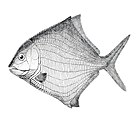Boreosomus
| Boreosomus Temporal range:
| |
|---|---|

| |
| Boreosomus slab and counterslab fossils at the Geological Museum in Copenhagen | |
| Scientific classification | |
| Kingdom: | Animalia
|
| Phylum: | Chordata
|
| Class: | |
| Order: | |
| Family: | |
| Genus: | †Boreosomus Stensiö, 1921
|
| Type species | |
| †Acrolepis arctica Woodward, 1912
| |
| Other species | |
| Synonyms | |
|
Diaphorognathus Brough, 1933 | |

Boreosomus (meaning: "boreal body") is an extinct genus of Triassic ray-finned fish. It was first described from the Arctic island of Spitsbergen (Svalbard, Norway), but was later also discovered in other parts of the world. Boreosomus had a worldwide distribution during the Early Triassic. Fossils of Boreosomus were found, apart from Spitsbergen, in Greenland, Madagascar and Canada.[2] The type species is Boreosomus arcticus (= Acrolepis arctica Woodward, 1912).
Boreosomus belongs to the family Ptycholepidae (= Boreosomidae/Chungkingichthyidae). Other genera of this family are (Spitsbergen), Ardoreosomus (Nevada, United States), (China), Ptycholepis (global) and Yuchoulepis (China).[3] A characteristic feature of this family is the dorsal fin, which inserts at the level of the pelvic fins in the middle portion of the body. Most contemporary ray-fins have their dorsal fin in a more posterior position, often opposite to the anal fin. Also typical for ptycholepids are the somewhat rectangular, horizontally arranged suborbital bones.
See also[]
- Prehistoric fish
- List of prehistoric bony fish
References[]
- ^ "Palaeonisciformes". Paleobiology Database. Retrieved November 17, 2012.
- ^ "Fossilworks: Boreosomus".
- ^ C. Romano, A. López-Arbarello, D. Ware, J. F. Jenks, and W. Brinkmann. 2019. Marine Early Triassic Actinopterygii from the Candelaria Hills (Esmeralda County, Nevada, USA). Journal of Paleontology 93:971-1000 https://doi.org/10.1017/jpa.2019.18
- Prehistoric ray-finned fish genera
- Palaeonisciformes
- Prehistoric ray-finned fish stubs
- Triassic fish stubs





